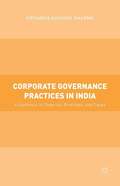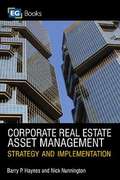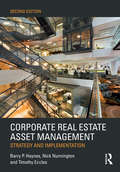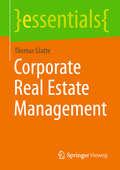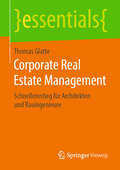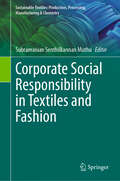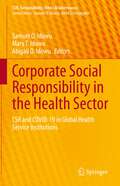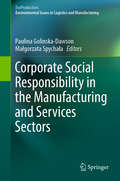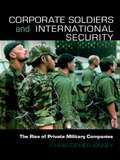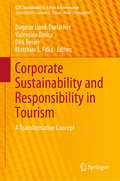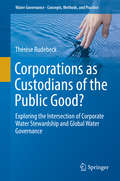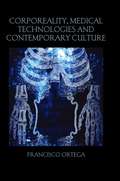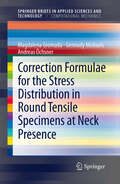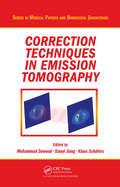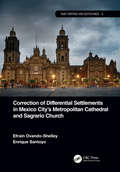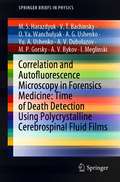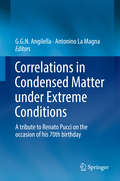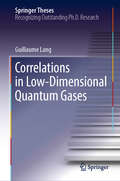- Table View
- List View
Corporate Environmental Strategies and Value Creation: Challenges and Opportunities (SpringerBriefs in Business)
by Rosita CapurroThe rise of sustainability has swept away the traditional views about firms’ competitiveness, survival and profitability, advocating new approaches. Although the strategic decisions on sustainable issues become more important, many firms have erroneously narrow view of environmental strategies and related practices generally have only an outward-looking focus. In line with these considerations, this book aims to investigate the “environmental dimension” as a new “strategic variable” for contributing to strengthen the competitive positioning of firms and to increase the value creation process. The author provides a comprehensive framework for green management by highlights practices and tools to translate strategy into effective environmental ideas. The focus is on goals and actions, from a side, and on the implementation of appropriate control systems useful for monitoring the results of environmental performance, on the other. As such, the book enriches sustainability literature, offers new insights for scholars, and provides implications for practitioners involved in green management.
Corporate Environmental Strategy: Theoretical, Practical, and Ethical Aspects (SpringerBriefs in Applied Sciences and Technology)
by Voicu D. DragomirThis book is a first step towards understanding the complexity of corporate environmental strategy while explaining the relationships between the numerous dimensions of the concept. When we think of corporate environmental strategy, we usually have in mind a dull and stereotypical statement issued by the CEO, addressing aspects such as pollution reduction, stakeholder dialogue, and unfailing care for the environment. However, genuine environmental protection relies on proactive policies, managerial commitment, cleaner technologies, and advanced management procedures. The author identifies a series of environmental strategy dimensions, some of which have been thoroughly researched in the literature, whereas others have only emerged in recent years. The main dimensions presented in this book include corporate environmental performance; environmental accounting and disclosure; environmental management practices; greening the supply-chain; environmental values and responsibility; green entrepreneurship and innovation; environmental training, culture and policies; and environmental legitimacy and reputation. For each dimension, the author develops a discussion framework, which provides the necessary operational definitions, methodological implications, and practical situations in which these constructs can be used. Each section contains a visual representation of the relationships between the dimensions of corporate environmental strategy and the actions of decision-makers and relevant stakeholders.
Corporate Governance Practices in India
by Priyanka Kaushik SharmaCorporate Governance Practices in India examines corporate governance practice in Indian industry. This book critically analyses the governance practice and evaluates the needs of corporate governance in the two major industries in India: Auto Industry and Heavy Engineering Industry. The study explores the state of compliance of the key governance parameter in both the industries in line with the mandatory and non-mandatory requirements stipulated by the Revised Clause 49 of (SEBI) ListingAgreement as also the provisions required by the Companies Act, 1956. The book aims to study the concept of corporate governance and check the level of compliance of corporate governance codes in Auto Industry and Heavy Engineering Industry in India, and draw comparisons in the adoption of corporate governance practices by Auto Industry vis-#65533;-vis Heavy Engineering Industry.
Corporate Real Estate Asset Management
by Nick Nunnington Barry HaynesIt is important for those studying and practicing in real estate and property management to learn to manage property assets effectively, to be able to provide their companies with effective property and facilities solutions. This book raises the awareness of how real estate management can support business, transform the workplace and impact upon people and productivity, ensuring that costs are minimized and profit maximized. Written for advanced undergraduate students on property related courses, it provides them with a rounded understanding by aligning the subject with estates management, facilities management and business strategy. Case studies and action plans provide real insight and make this book an essential reference for those at the start of their careers in real estate and facilities management.
Corporate Real Estate Asset Management: Strategy and Implementation
by Nick Nunnington Barry Haynes Timothy EcclesThe second edition of Corporate Real Estate Asset Management is fully up to date with the latest thought and practice on successful and efficient use of corporate office space. Written from an occupier’s perspective, the book presents a ten-point CREAM model that offers advice on issues such as sustainability, workplace productivity, real estate performance measurement, change management and customer focus. In addition, new case studies provide real-life examples of how corporations in the UK, USA, Hong Kong and Abu Dhabi actively manage their corporate real estate. The book is aimed at advanced undergraduate and graduate students on corporate real estate, facilities management and real estate courses and international MBA programmes.
Corporate Real Estate Management: Schnelleinstieg Für Architekten Und Bauingenieure (essentials)
by Thomas GlatteThomas Glatte provides a comprehensive view on the essentials of corporate real estate management (CREM). The author explains in the influence of corporate strategies on real estate strategies for non-property-companies as well as the importance of corporate real estate portfolios, the set-up of CREM organizations and the handling of respective services. He also elaborates the specifics of corporate social responsibility, sustainability, corporate architecture & design and workplace management.
Corporate Real Estate Management: Schnelleinstieg für Architekten und Bauingenieure (essentials)
by Thomas GlatteThomas Glatte vermittelt in kompakter Form die Grundlagen und ausgewählte Spezifika des Corporate Real Estate Managements. Der Autor erläutert den Einfluss der Unternehmensstrategie auf die Immobilienstrategie von Non-Property-Unternehmen sowie die Bedeutung der betrieblichen Immobilienportfolien, den Aufbau einer CREM-Organisation und den Umgang mit immobilienwirtschaftlichen Dienstleistungen. Zudem erklärt er spezifische Aspekte des CREM wie CSR, Nachhaltigkeit, Corporate Architecture & Design und Workplace Management.Der Autor: Dr.-Ing. Thomas Glatte ist Director Group Real Estate Management bei einem Industriekonzern sowie Lehrbeauftragter an der TU Dresden und der Universität Stuttgart. Er ist Autor zahlreicher Fachpublikationen zu immobilienwirtschaftlichen Themen. Darüber hinaus ist Dr. Glatte Vorstand im CREM-Fachverband CoreNet Global sowie Mitglied des Immobilienbeirats der DGNB.
Corporate Safety Compliance: OSHA, Ethics, and the Law (Occupational Safety & Health Guide Series)
by Thomas D. SchneidSafety and health professionals face a variety of potential legal and ethical issues. As a result of changing responsibilities and new laws, professionals often find themselves in situations without guidance toward the solutions. This book provides such guidance to legal issues involving OSHA and how to avoid potential legal areas of liability if possible. Tackling safety and ethical issues head on, the text explores the area of criminal liability for individuals and corporations under the OSHA Act and state criminal codes. The author also gives methods to achieve and to maintain OSHA compliance, using specific case studies to illustrate ways to avoid or to minimize the impact of legal issues.
Corporate Social Responsibility in Textiles and Fashion (Sustainable Textiles: Production, Processing, Manufacturing & Chemistry)
by Subramanian Senthilkannan MuthuThis contributed volume provides a wealth of case studies on corporate social responsibility in the textile and fashion industry. The cases presented here are geographically diverse and cover a host of topics ranging from sustainability aspects of slow fashion to how fast fashion can become more sustainable. The fashion and textile supply chain is discussed, as well as how tools such as life cycle assessment can contribute to a more responsible textile industry. This book highlights how being a responsible corporate citizen can contribute to a firm's bottom line as well as make its products more attractive to conscientious consumers.
Corporate Social Responsibility in the Construction Industry
by Mike Murray Andrew DaintyThe construction process, right through from planning and design to use and demolition, has a major impact on society. Traditionally, concern has been focused on its environmental impact and the quest for sustainability, but this has now extended into the wider remit of Corporate Social Responsibility (CSR). Essentially, this means that businesses must act (voluntarily) in a socially ethical manner by developing a policy that encompasses the core principles enshrined by CSR. A unique presentation on a topic of emerging importance, Corporate Social Responsibility in the Construction Industry is essential reading for all built environment undergraduate and post-graduate courses, as well as CEOs and senior managers within construction businesses who may be about to embark on developing a CSR strategy.
Corporate Social Responsibility in the Health Sector: CSR and COVID-19 in Global Health Service Institutions (CSR, Sustainability, Ethics & Governance)
by Samuel O. Idowu Mary T. Idowu Abigail O. IdowuThe pandemic that struck in late 2019 - the coronavirus, commonly referred to as COVID-19 - affected every country in the world. This book examines how the pandemic has impacted healthcare institutions worldwide, and focuses on the international experience of COVID-19 in terms of healthcare delivery since 2019 and today. It highlights how healthcare facilities around the world have managed and continue to manage their obligations to their citizens. The book’s goal is to improve our understanding of the many negative and positive impacts of the pandemic on various aspects of our lives, including the health aspect, and how healthcare institutions could expand their ability to manage similar pandemics in the future without seriously compromising their ability to address other, regular health issues. At the same time, it takes a closer look at CSR, sustainability, ethics, and governance issues related to the pandemic, as well as current CSR practices in each of the countries reviewed.Given its scope, the book will be of interest to a broad readership including researchers, practitioners, and students concerned with the pandemic’s societal and public health implications.
Corporate Social Responsibility in the Manufacturing and Services Sectors (EcoProduction)
by Paulina Golinska-Dawson Małgorzata SpychałaCorporate Social Responsibility (CSR) is an important element in creating competitive advantages for enterprises in different sectors. The authors guide readers through the different cases studies in order to present the benchmarking of international standards and CSR initiatives, as well as CSR performance evaluation practices. This book aims to identify current problems that can arise during CSR implementation in manufacturing and services companies. Moreover some best practice examples suitable for the introduction of CSR in the small and medium size companies will be described. The authors show how different stakeholders can benefit from sustainable resource management and pro-social behaviors. This book will be a valuable resource for both academics and practitioners who want to deepen their knowledge of CSR. This scientific monograph has been doubled blind reviewed.
Corporate Soldiers and International Security: The Rise of Private Military Companies (Contemporary Security Studies)
by Christopher KinseyThis book traces the history of private military companies, with a special focus on UK private forces. Christopher Kinsey examines the mercenary companies that filled the ranks of many European armies right up to the 1850s, the organizations that operated in Africa in the 1960s and early 1970s, the rise of legally established private military companies in the late 1970s and early 1980s, and today’s private and important actors in international security and post-conflict reconstruction. He shows how and why the change from the mercenary organizations of the 1960s and 1970s came about, as the increasing newness of private military companies came to be recognised. It then examines how PMCs have been able to impact upon international security. Finally, Kinsey looks at the type of problems and advantages that can arise for organizations that decide to use private military companies and how they can make an unique contribution to international security. Corporate Soldiers and International Security will be of great interest to all students of international politics, security studies and war studies.
Corporate Sustainability and Responsibility in Tourism: A Transformative Concept (CSR, Sustainability, Ethics & Governance)
by Matthias S. Fifka Dagmar Lund-Durlacher Dirk Reiser Valentina DinicaThis book offers essential insights into how the world's second largest industry, tourism, is responding to challenges involved in expanding the corporate social responsibility (CSR) concept to corporate sustainability and responsibility, referred to as CSR 2.0. It analyzes the typical setup of tourism with various types of commercial agents: corporations, small and medium sized enterprises, public-private partnerships, social enterprises and local cooperatives. In addition, the book examines a broad range of voluntary initiatives, the effectiveness of these efforts, and how contextual and wider policy features shape these relationships. The book is divided into three parts, the first of which elaborates on strategic drivers and rationales for CSR. In turn, the second part introduces readers to design approaches for CSR programs and envisaged impacts, while part three focuses on implementation, certification, reporting, and possible outcomes. Each part offers a mixture of theoretical perspectives, synthesis analyses and case studies. The respective chapters tackle a broad spectrum of tourism sub-sectors, e.g. the cruise industry, aviation, gastronomy, nature-based tourism, and urban destinations.
Corporate Warriors
by P. W. SingerSome have claimed that ?War is too important to be left to the generals,? but P. W. Singer asks ?What about the business executives? Breaking out of the guns-for-hire mold of traditional mercenaries, corporations now sell skills and services that until recently only state militaries possessed. Their products range from trained commando teams to strategic advice from generals. This new ?Privatized Military Industry? encompasses hundreds of companies, thousands of employees, and billions of dollars in revenue. Whether as proxies or suppliers, such firms have participated in wars in Africa, Asia, the Balkans, and Latin America. More recently, they have become a key element in U. S. military operations. Private corporations working for profit now sway the course of national and international conflict, but the consequences have been little explored. In this book, Singer provides the first account of the military services industry and its broader implications. Corporate Warriors includes a description of how the business works, as well as portraits of each of the basic types of companies: military providers that offer troops for tactical operations; military consultants that supply expert advice and training; and military support companies that sell logistics, intelligence, and engineering. The privatization of warfare allows startling new capabilities and efficiencies in the ways that war is carried out. At the same time, however, Singer finds that the entrance of the profit motive onto the battlefield raises a series of troubling questions'for democracy, for ethics, for management, for human rights, and for national security.
Corporations as Custodians of the Public Good?: Exploring the Intersection of Corporate Water Stewardship and Global Water Governance (Water Governance - Concepts, Methods, and Practice)
by Thérèse RudebeckThis book provides a comprehensive assessment of how local corporate water strategies influence global water governance objectives. In various geographies, companies spearhead a quest for more sustainable water management within and beyond their own operations. This book critically examines such strategies and provides an overarching analysis of the effects that mounting corporate involvement has had on the global water discourse. More specifically, it explains why companies from the food, beverage, textile, and mining sectors have started to incorporate water management objectives into their business strategies, how companies work in partnerships with other stakeholders to realize these objectives, and how these actions acquire wider political legitimacy. It presents insightful interview material from business leaders and other high-level stakeholders. Readers will gain the necessary knowledge to develop a critical view and respond appropriately.
Corporeality, Medical Technologies and Contemporary Culture: Corporeality, Medical Technologies And Contemporary Culture (Birkbeck Law Press)
by Francisco OrtegaThis book examines the confusions and contradictions that manifest in prevalent attitudes towards the body, as well as in related bodily practices. The body is simultaneously our reference for the certainties of nature and the locus of a desire for transformation and reinvention. The body is at the same time worshipped and despised; an object of desire and of design. Francisco Ortega analyses how the body has become both a screen for the projection of our ideas and imaginings about ourselves and conversely an object of suspicion, anxiety, and discomfort. Addressing practices of corporeal ascesis (such as bodybuilding and dietetics), medical technologies, and radical anatomical modifications, Ortega documents the ambiguous legacy of a western theoretical tradition that has always despised the body. Utilising a theoretical framework that is mainly informed by the phenomenology of the body, feminist theory, disability studies and the thought of Michel Foucault, Corporeality, Medical Technologies and Contemporary Culture address several ethical and psychological issues associated with the experience and perception of the body in our cultural landscape. Drawing on these diverse areas of philosophical and analytical work, this book will interest those researching Law, Medicine, and Sociology.
Correct-by-Construction System on Chip Design
by Parthasarathi Roop Samik Basu Roopak SinhaThis book describes an approach for designing Systems-on-Chip such that the system meets precise mathematical requirements. The methodologies presented enable embedded systems designers to reuse intellectual property (IP) blocks from existing designs in an efficient, reliable manner, automatically generating correct SoCs from multiple, possibly mismatching, components.
Correction Formulae for the Stress Distribution in Round Tensile Specimens at Neck Presence (SpringerBriefs in Applied Sciences and Technology)
by Andreas Öchsner Magdalena Gromada Gennady MishurisThe monograph deals with methods to determine mechanical properties and evaluate the flow curve of ductile materials from the tensile test. It presents classical hypotheses concerning the onset of neck creation as well as the state of the art in determining the mechanical properties from the tensile test, with emphasis on the consequences of the neck formation. It revises derivations of formulae for the stress distribution in the minimal cross-section of the axisymmetrical specimen in the classical approaches proposed by Bridgman, Davidenkov / Spiridonova and Siebel as well as in the less famous formulae derived by Szczepinski and Malinin / Petrosjan. The revision is completed with solutions evaluated by the authors. In the monograph, the simplifying assumptions utilised in the classical approaches were carefully verified by numerical simulations accompanied by theoretical analysis. Errors imposed in the evaluation of the average axial stress acting on the minimal cross-section as a result of every particular simplification are estimated. The accuracy of all formulae to evaluate the flow curve is discussed. The significance of a high accurate determination can be seen in the context of numerical simulation (e.g. finite element computations), where the total error and accuracy is partly based on the accuracy of the material input.
Correction Techniques in Emission Tomography (Series in Medical Physics and Biomedical Engineering)
by Xiaoyi Jiang Mohammad Dawood Klaus SchäfersWritten by an interdisciplinary team of medical doctors, computer scientists, physicists, engineers, and mathematicians, Correction Techniques in Emission Tomography presents various correction methods used in emission tomography to generate and enhance images. It discusses the techniques from a computer science, mathematics, and physics viewpoint.
Correction of Differential Settlements in Mexico City's Metropolitan Cathedral and Sagrario Church (Built Heritage and Geotechnics)
by Efraín Ovando-Shelley Enrique SantoyoThis book describes the geotechnical aspects for correcting the geometry of Mexico City´s Metropolitan Cathedral and of the adjoining Sagrario Church. It describes the main aspects of geotechnical conditions in the city and of the most important hazards affecting these monuments. It discusses the analyses performed and the actions taken to achieve the corrections required. The book aims to provide non-specialists with a clear picture of the magnitude and importance of the project and of the achievements it fulfilled. It is expected that the book will also appeal to specialized geotechnical engineers that will be provided with references to follow up the project in depth. The book will contain a large number of illustrations and will be written so as to provide "down to earth" explanations of the basic theories applied and of the actual construction procedures The work will appeal to both students and professionals in the fields of Architecture and Civil Engineering. It will also interest specialized audiences of geotechnical engineers and conservation architects and it may also be of value to art historians.
Correlated Functional Oxides: Nanocomposites and Heterostructures
by Paolo Mele Tamio Endo Hiroaki Nishikawa Nobuyuki Iwata Yayoi Takamura Gun-Hwan LeeThis book introduces a variety of basic sciences and applications of the nanocomposites and heterostructures of functional oxides. The presence of a high density of interfaces and the differences in their natures are described by the authors. Both nanocomposites and heterostructures are detailed in depth by researchers from each of the research areas in order to compare their similarities and differences. A new interfacial material of heterostructure of strongly correlated electron systems is introduced.
Correlation and Autofluorescence Microscopy in Forensics Medicine: Time of Death Detection Using Polycrystalline Cerebrospinal Fluid Films (SpringerBriefs in Physics)
by A. G. Ushenko Yu. A. Ushenko I. Meglinski M.S. Harazdyuk V.T. Bachinsky O.Ya. Wanchulyak A.V. Dubolazov M.P. Gorsky A.V. BykovThis book highlights the first systematic synthesis of various research approaches in forensic medical diagnosis of the morphological and polycrystalline structure of human biological tissues and biological fluids. One of the global challenges in such diagnosis is the assessment of actual time of death. The relevance and objectivity of such studies are given by the innovative use of complex multifunctional methods using lasers and Mueller-matrix polarimetry, which is presented in this book. As a result, within the framework of the statistical, correlation and fractal approaches, diagnostic relationships were established between the time parameters of the transformation of the topographic structure of polarization-inhomogeneous microscopic images of biological preparations and necrotic changes in the morphological structure of biological tissues of the deceased. On this foundation, new forensic medicine criteria have been developed for objective determination of time of death.
Correlations in Condensed Matter under Extreme Conditions: A tribute to Renato Pucci on the occasion of his 70th birthday
by Antonino La Magna G. G. AngilellaThis book addresses a wide range of topics relating to the properties and behavior of condensed matter under extreme conditions such as intense magnetic and electric fields, high pressures, heat and cold, and mechanical stresses. It is divided into four sections devoted to condensed matter theory, molecular chemistry, theoretical physics, and the philosophy and history of science. The main themes include electronic correlations in material systems under extreme pressure and temperature conditions, surface physics, the transport properties of low-dimensional electronic systems, applications of the density functional theory in molecular systems, and graphene. The book is the outcome of a workshop held at the University of Catania, Italy, in honor of Professor Renato Pucci on the occasion of his 70th birthday. It includes selected invited contributions from collaborators and co-authors of Professor Pucci during his long and successful career, as well as from other distinguished guest authors.
Correlations in Low-Dimensional Quantum Gases (Springer Theses)
by Guillaume LangThe book addresses several aspects of thermodynamics and correlations in the strongly-interacting regime of one-dimensional bosons, a topic at the forefront of current theoretical and experimental studies. Strongly correlated systems of one-dimensional bosons have a long history of theoretical study. Their experimental realisation in ultracold atom experiments is the subject of current research, which took off in the early 2000s. Yet these experiments raise new theoretical questions, just begging to be answered. Correlation functions are readily available for experimental measurements. In this book, they are tackled by means of sophisticated theoretical methods developed in condensed matter physics and mathematical physics, such as bosonization, the Bethe Ansatz and conformal field theory. Readers are introduced to these techniques, which are subsequently used to investigate many-body static and dynamical correlation functions.


